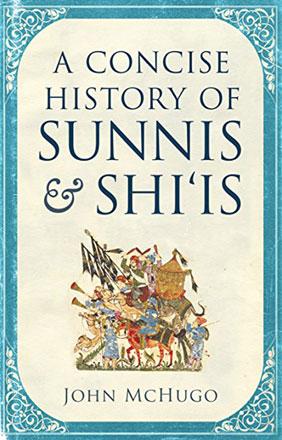You are here
Sectarianism is not inevitable
By Sally Bland - Nov 12,2017 - Last updated at Nov 12,2017

A Concise History of Sunnis and Shi’is
John McHugo
London: Saqi Books, 2017
Pp. 347
Aside from the intrinsic fascination that history holds for many, the ultimate rational for studying it is to glean lessons that might help in designing a better world for the future. “A Concise History of Sunnis and Shi’is” certainly meets this criterion by tackling a current issue, sectarianism, that has brought so much suffering to people in the Middle East and beyond, in recent years. British scholar John McHugo guides the reader through Muslim history from the time of the Prophet Muhammad, peace be upon him, until today, to reach a potentially game-changing conclusion: “Co-operation across the sectarian divide has always been possible. There is nothing inevitable about conflict between Sunnis and Shi’is.” (p. 306)
It is no mean feat to cover over 1400 years of history in a book that is correctly termed concise. McHugo strikes a good balance between charting overall trends and highlighting significant details as he reviews the development of Islam from a small community of believers into an empire, subsequently multiple empires, and finally the majority religion in the Arab countries, Turkey, Iran, Pakistan and Afghanistan. (The book also includes India and Indonesia when relevant to the focus on Sunni-Shi’i relations.)
McHugo covers the teachings of a broad array of Muslim scholars, both Sunni and Shi’i, and the debates among them, whether on religious doctrine or on the relation of religion to state power. His descriptions of the political and economic context in which these debates occurred is masterful, and his profiles of the leading figures at different stages are fascinating. His charting of migration patterns that spread Islam and its different branches to various locations is very instructive, especially since he ties it into today’s demographic realities as to where Sunnis and Shi’is are found.
Throughout this historical review, it is eye-catching that most instances of Sunni-Shi’i discord have occurred in conjunction with power struggles, even when they appeared to involve doctrinal disputes. For example, harsh measures taken by Ottoman sultans against their Shi’i subjects in the 16th century were mainly motivated by fear that the latter might support the rival Safavid Empire. Many contrary examples are also cited of political and religious leaders who in some way straddled the Sunni-Shi’i divide, or attempted to close the gap between them, such as Emperor Akbar, a Sunni Muslim who headed the Mughal Empire that covered most of India in the 16th century. He instituted a policy of universal tolerance which gained the loyalty of Sunnis, Shi’is and Hindus alike, and precluded sectarian strife. McHugo also notes the bridging role of Sufism which over the centuries “could seem to come remarkably close to Shi’ism, while technically remaining Sunni”. (p. 138)
In fact, before the advent of colonialism, the only significant trend within Sunni Islam that was uncompromisingly opposed to Shi’ism was the movement begun by Ibn Abd Al Wahhab, about whom McHugo writes, “Although he saw himself as uniting Muslims, his actions divided communities against themselves, and those divisions persist to this day.” (p. 176)
The book is logically divided into two parts with the second part covering the last 200 years starting with the colonial era and the imposition of Western dominance. “The Muslim world has been a very different place during this period, no longer able to set its own terms of reference and decide its own agendas.” (p. 185)
While, initially, the need of Muslim societies to defend themselves from colonial penetration led to greater Sunni-Shi’i cooperation, over time Western hegemony enacted huge political and economic changes that sometimes widened the gap between the two.
McHugo analyses the interplay between pan-Islamism and Arab nationalism, and how the former eventually surpassed the latter, as well as the impact of colonial policies and flawed state formations on Sunni-Shi’i relations. In his review of the earth-shaking events that have marked the Middle East from the Iranian Revolution to the rise of Daesh, it once again becomes apparent that most sectarian conflict has had political and/or socioeconomic, rather than religious, roots, and has been exacerbated by imperialist intervention, most obviously in the case of Iraq. He cites numerous examples of how various regimes have exploited the Sunni-Shi’i divide to their own purposes, to keep their own population under control or to increase their regional clout — all building up to the disastrous situation of today.
McHugo does not view reality through rose-tinted glasses, yet the book gives cause for hope by taking a long view of history: “There have always been tensions between Sunnis and Shi’is, but there has never been sectarian strife between them to compare with the wars of religion and persecutions of the Reformation in Christian Europe…” (p. 304)
If class factors once trumped sectarianism in Iraq, if sectarianism was absent in Yemen until the 21st century, if people of all persuasions rose up across the region for freedom and dignity only a few years ago, the tide can turn again.
Related Articles
While 40 years of seldom-interrupted stability under Hafez and Bashar Assad’s rule may make today’s chaos appear as an anomaly
Much of “Enemy on the Euphrates” reads like a great adventure story, proving how fascinating real history can be
The Alawis of Syria: War, Faith and Politics in the LevantEdited by Michael Kerr and Craig LarkinLondon: Hurst and Company, 2015Pp.


















